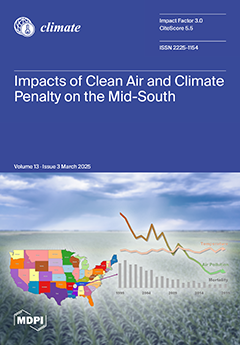It is imperative to assess and comprehend the hydrological processes of the river basin in light of the potential effects of land use/land cover and climate changes. The study’s main objective was to evaluate hydrologic response of water balance components to the projected land use/land cover (LULC) and climate changes in the Omo–Gibe River Basin, Ethiopia. The study employed historical precipitation, maximum and minimum temperature data from meteorological stations, projected LULC change from module for land use simulation and evaluation (MOLUSCE) output, and climate change scenarios from coupled model intercomparison project phase 6 (CMIP6) global climate models (GCMs). Landsat thematic mapper (TM) (2007) enhanced thematic mapper plus (ETM+) (2016), and operational land imager (OLI) (2023) image data were utilized for LULC change analysis and used as input in MOLUSCE simulation to predict future LULC changes for 2047, 2073, and 2100. The predictive capacity of the model was evaluated using performance evaluation metrics such as Nash–Sutcliffe Efficiency (NSE), the coefficient of determination (R2), and percent bias (PBIAS). The bias correction and downscaling of CMIP6 GCMs was performed via CMhyd. According to the present study’s findings, rainfall will drop by up to 24% in the 2020s, 2050s, and 2080s while evapotranspiration will increase by 21%. The findings of this study indicate that in the 2020s, 2050s, and 2080s time periods, the average annual Tmax will increase by 5.1, 7.3, and 8.7%, respectively under the SSP126 scenario, by 5.2, 10.5, and 14.9%, respectively under the SSP245 scenario, by 4.7, 11.3, and 20.7%, respectively, under the SSP585 scenario while Tmin will increase by 8.7, 13.1, and 14.6%, respectively, under the SSP126 scenario, by 1.5, 18.2, and 27%, respectively, under the SSP245 scenario, and by 4.7, 30.7, and 48.2%, respectively, under the SSP585 scenario. Future changes in the annual average Tmax, Tmin, and precipitation could have a significant effect on surface and subsurface hydrology, reservoir sedimentation, hydroelectric power generation, and agricultural production in the OGRB. Considering the significant and long-term effects of climate and LULC changes on surface runoff, evapotranspiration, and groundwater recharge in the Omo–Gibe River Basin, the following recommendations are essential for efficient water resource management and ecological preservation. National, regional, and local governments, as well as non-governmental organizations, should develop and implement a robust water resources management plan, promote afforestation and reforestation programs, install high-quality hydrological and meteorological data collection mechanisms, and strengthen monitoring and early warning systems in the Omo–Gibe River Basin.
Full article





